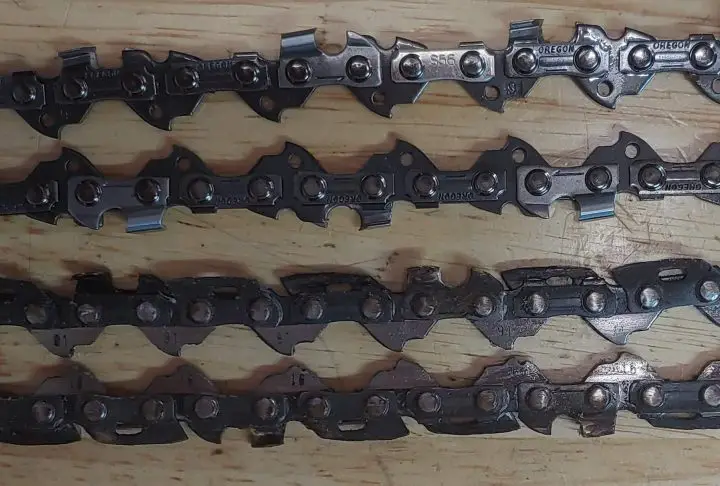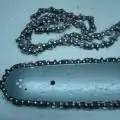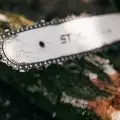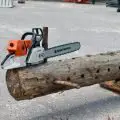Some chainsaw chains are made to reduce the kickback reaction force. These chains must be sold with every new chainsaw that has an engine displacement of less than 66 cubic centimeters, and they can be found on a variety of chainsaws used by homeowners, arborists, and loggers.
In this article, we’ll provide all the relevant information on what low kickback chainsaw chains are along with how they work, their benefits, and their drawbacks.
Table of Contents
- What Are Low Kickback Chainsaw Chains?
- How Do Low Kickback Chainsaw Chains Work?
- Low Kickback Chain Drawbacks vs Normal Chains
- FAQs (Frequently Asked Questions)
What Are Low Kickback Chainsaw Chains?
Low kickback, or safety, is exactly what to expect from a low-kickback chainsaw chain. Because most of these chains have a larger rubbing surface area than a full-pro chain, they typically run hotter. Therefore, this has a greater propensity to clog than an ordinary chain. If this hasn’t been an issue, you must be doing an excellent job of keeping an edge on your chain.
The outside edge and working corner of a low kickback chain are often rounded as opposed to the square corner of a chisel chain. Not all semi-chisels, however, are safety chains, and not all safety chains are semi-chisels. When it comes to performance, a sharp chisel chain dominates. A semi-chisel will maintain an edge somewhat longer in less-than-perfectly clean wood, and it also appears to produce a cleaner cut in the bark of a branch collar if you are pruning.
The additional components of a safety chain, including the tie strap’s humps and depth gauges with ramps, increase friction and slow chip clearing, which is a key element in cutting speed.
Low kickback chains are made to not bite as deeply into the upper region of the bar tip because kickback is typically linked with that area. As a result, these bars and chains do not bore cut as well but are still OK if you don’t bore cut frequently.
Positively, some low kickback chains cut more smoothly because of the bumpers, especially on smaller-diameter wood. According to Oregon, this was the initial objective of the design, and the decreased likelihood of kickbacks was an unintended side consequence. Learn all about Types of Chainsaw Chains in our complete guide!

How Do Low Kickback Chainsaw Chains Work?
Let’s first examine how a typical saw chain cuts wood fibers in order to comprehend how these chains function. Each cutter link has a heel, a toe, and rivet holes on the underside. The depth gauge, the gullet, the cutting corner, the side plate, and the top plate are all located on the top half, running from front to back.
The depth gauge, which is occasionally incorrectly called the raker, does not remove chips in the same manner as a raker on a crosscut saw. When the cutting corner snags and then severs fiber, the depth gauge just set the depth or thickness of the chip that will be created. Because they control the size of the chip and the strength of the reactive forces, depth gauges serve as a safety feature. The severity of the potential kickback increases with chip thickness.
Kickback-reducing features on chains restrict the amount of fiber that can be hooked by the working corner as it rounds the upper half of the bar tip, which is referred to as the kickback zone, in order to reduce the potential for reactive forces.
Adding extra metal to the tie straps between the cutting teeth is a typical method for accomplishing this. As the chain circles the upper half of the bar tip, the tie straps act as a deeper depth gauge. (Tie straps join the cutting links to the drive links; bumper tie straps have a higher profile than standard tie straps to avoid the cutting tooth hooking fiber.)
Drive links with built-in bumpers and depth gauges with ramps are two more anti-kickback strategies that can be used to somewhat deflect fiber as the chain passes the kickback zone. A chain cannot be deemed low-kickback unless it complies with ANSI Standard B175.1.
Learn all about chainsaw kickback in our guide!
Low Kickback Chain Drawbacks vs Normal Chains
Low-kickback chains have two significant disadvantages, the first of which is that the kickback zone is essentially useless for bore cutting. This is probably not a problem if the majority of your chainsaw work consists of bucking firewood.
However, there is a problem if you are felling trees in a specific direction and utilizing a bore cut to construct your back cut, which is a safety measure meant to reduce “barber chair” and other risky felling scenarios. Bore cuts with low-kickback chains go very slowly, if at all because the upper part of the bar tip won’t cut well.
More about parts of a chainsaw on the blog.
The safety chain’s potential to be more difficult to sharpen is its second downside. This is not a problem if you take your saw to the dealer for sharpening anyway, but if you do it yourself and don’t maintain the chain properly, you’ll introduce a new risk factor by pressing down too hard on the saw out of frustration, which can negate the benefit of the safety chain in the first place. Knowing how to operate a piece of safety equipment properly is crucial, just like with everything else.
In most people’s experience, a well-maintained full-pro chisel chain will always outcut a safety chain. The pro chisel chain will provide you with considerably more output from your saw than any of the safety chains if you are familiar with them and operate them correctly and responsibly. The pro chains may carry a larger risk, but if you really practice using the right saw technique and stance, I believe you are far better suited to using an unfettered chain than actually using this tool for work.
As mentioned already, not all low-kickback chainsaw chains will be semi-chisel chains. It’s possible to get full chisel low-kickback chains as can be observed in this YouTube video:o
FAQs (Frequently Asked Questions)
What is a low-kickback chain?
Chainsaw chains with low kickback are made to reduce the reactive force known as a kickback.
How can you tell if you have a low-kickback chain?
The outside edge and working corner of a low kickback chain are often rounded as opposed to the squared corner of a chisel chain. It’s important to note that not all semi-chisels, however, are low-kickback chains.
How common is chainsaw kickback?
The sudden, upward action of a chainsaw’s guide bar is referred to as “kickback.” It may surprise you to learn that improper chainsaw-cutting practices are one of the most frequent causes of accidents involving a chainsaw. Kickbacks might occur suddenly.
What is a lo pro chain?
Low profile, or “lo pro,” chain has shorter cutters than those found on regular chainsaw chains. Low profile chain thus creating a shallow cut.






